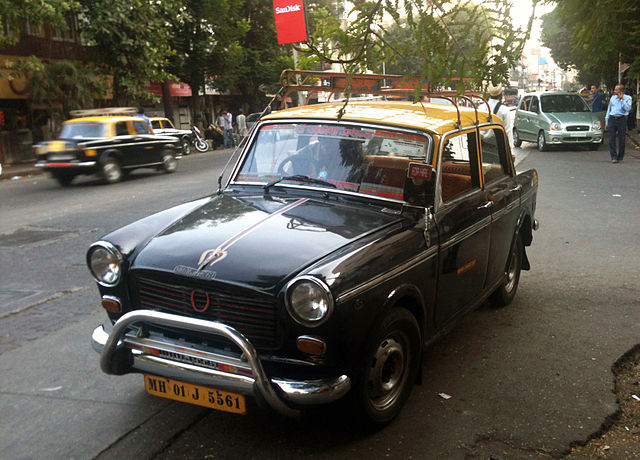Most of us associate a taxi in Mumbai with just one entity: The Black-and-Yellow Premier Padmini. I’m going to attempt to track Taxis in Bombay to their current scenario.

These cabs have been on the roads for decades and have remained the undisputed maharajas of South Bombay. They had competition from only one other entity; the Cool Cab. The Cool Cab is a better vehicle; often a Santro, Indica, or a WagonR. They are Blue in colour and air-conditioned. Naturally, their fares are higher.

Taxis first made their appearance in the city in 1911, to complement horse-drawn carriages. Traditionally, these taxis operate in the same way taxis operate across the world. The driver gets a Transport-Vehicle licence. Either the driver, or the owner buys the vehicle, approaches the Regional Transport Authority [RTA] for a commercial registration and a Taxicab permit. Then the vehicle is registered to one of the Unions operating under the jurisdiction of the Mumbai Metropolitan Regional Transport Authority [MMRTA].
Under Maharashtra regulations, a cab, like an auto cannot refuse a fare. As long as the Fare-Meter says ‘For Hire’ on it, the taxi driver has to take the commuter to their destination.
For years, these taxis [along with the blue counterparts] remained the primary for-hire service in the city, especially the South, where Autorickshaws are banned to reduce congestion.
The first step towards change, was in 2007 with the appearance of the Fullora Gold Taxi. The Fullora Foundation was an NGO that set up the Mumbai Gold Cab Company. Regular taxi owners were invited to join the company. The deal included the sale of their old Premier Padmini, getting ₹25,000 in hand, shares in the company, a new taxi as well as insurance. A move that the Mumbai Taximens Union vehemently opposed. Among the various reasons to oppose it, the Taxi Union stated that the plan would fail as they would not have a taxi stand and would operate round the clock. When launched, they had a fare lower than that of the standard Cool Cab. The fleet was composed of Esteems, Indigos and similar saloons.

What did this mean for the Common Man in Bombay?
Private cabs can be called when needed. This eliminates the need to look out for a taxi stand. They are mostly monitored by GPS. This makes it easy to track the cab. What really made me happy is the advent of Women-only cabs. Forsche [now Viira] and Priyadarshini cabs. Giving women drivers opportunities, and of course, women passengers feel safer that way.
What happened then?
By 2010, the market was saturated with many call-taxi operators, many of whom had pan-India operations, such as Meru, Mega Cabs, Easy Cabs, TabCabs, et al. The regular black-and-yellow as well as Cool Cabs continue to operate today, as do the Gold Cabs. Somewhere in 2011 Ola Cabs appeared on the scene as a taxi aggregator service. This was followed by Uber and other services. Surprisingly, however, Mumbai was fifth on Uber’s list. Ola and its subsidiary TaxiForSure [TFS], later on tied up with autos to allow you to find an auto on the spot with the app. TFS also launched Tata Nanos in Bangalore, although these are yet to be seen on the streets of Mumbai. Soon, others such as Meru, and TabCab too, lanched their mobile apps.
The scenario today:
The scenario today is rather simple. If you are in SoBo, you can hail a cab as easy as hailing an auto. Autos and Taxis, traditionally in Bombay have been honest, and rarely overcharge. However, if one is not carrying cash, then an Uber, or Ola would make sense, particularly due to the extremely low fares they charge from their users. Cabs, in the long run do help get user of private vehicles off the streets, but they are among the reasons why BEST is reducing its AC fleet. Its good to see technology being put to good use, for the benefit of the consumer, be it prepaid wallets and Mobile Apps for booking, or Prepaid RFID cards for buses.
![]()
